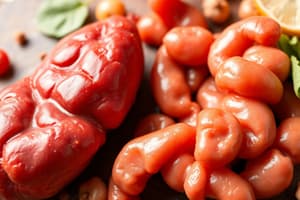Podcast
Questions and Answers
What is the primary site of lipid digestion in the body?
What is the primary site of lipid digestion in the body?
The small intestine
What is the role of cholecystokinin (CCK) in lipid digestion?
What is the role of cholecystokinin (CCK) in lipid digestion?
CCK signals the gallbladder to release bile and the pancreas to release digestive enzymes, including pancreatic lipase.
What is the function of bile salts in lipid digestion?
What is the function of bile salts in lipid digestion?
Bile salts emulsify lipids, keeping them dispersed in the watery environment of the small intestine.
What is the difference between monoglycerides and diglycerides?
What is the difference between monoglycerides and diglycerides?
What is the role of gastric lipase in lipid digestion?
What is the role of gastric lipase in lipid digestion?
How does salivary lipase contribute to lipid digestion?
How does salivary lipase contribute to lipid digestion?
What is the purpose of emulsification in lipid digestion?
What is the purpose of emulsification in lipid digestion?
Why are triglyceride digestion and absorption more complicated than those of sugars and starches?
Why are triglyceride digestion and absorption more complicated than those of sugars and starches?
What is the purpose of bile salts in lipid digestion?
What is the purpose of bile salts in lipid digestion?
What is the product of triglyceride digestion by pancreatic lipase?
What is the product of triglyceride digestion by pancreatic lipase?
What is the role of phospholipase in lipid digestion?
What is the role of phospholipase in lipid digestion?
What happens to cholesterol during lipid digestion?
What happens to cholesterol during lipid digestion?
What are the end products of lipid digestion?
What are the end products of lipid digestion?
How do short- and medium-chain fatty acids enter the bloodstream?
How do short- and medium-chain fatty acids enter the bloodstream?
What is the function of chylomicrons?
What is the function of chylomicrons?
How do chylomicrons enter the bloodstream?
How do chylomicrons enter the bloodstream?
What is the role of lipoprotein lipase in lipid metabolism?
What is the role of lipoprotein lipase in lipid metabolism?
Why are medium-chain triglycerides (MCTs) used in medical treatment?
Why are medium-chain triglycerides (MCTs) used in medical treatment?
What happens to the fatty acids and glycerol molecules after nearby cells pick them up?
What happens to the fatty acids and glycerol molecules after nearby cells pick them up?
What is the purpose of enterohepatic circulation?
What is the purpose of enterohepatic circulation?
Why is fat a more concentrated source of energy than carbohydrate or protein?
Why is fat a more concentrated source of energy than carbohydrate or protein?
What is the function of adipose cells?
What is the function of adipose cells?
What happens to excess glucose and certain amino acids in the body?
What happens to excess glucose and certain amino acids in the body?
What is the role of the liver in lipid digestion and absorption?
What is the role of the liver in lipid digestion and absorption?
What is the significance of the lymphatic/immune system in lipid transportation?
What is the significance of the lymphatic/immune system in lipid transportation?
What happens to glycerol molecules released by adipose cells?
What happens to glycerol molecules released by adipose cells?
How can interfering with enterohepatic circulation affect blood cholesterol levels?
How can interfering with enterohepatic circulation affect blood cholesterol levels?
What is the effect of alcohol consumption on triglyceride synthesis?
What is the effect of alcohol consumption on triglyceride synthesis?
Flashcards are hidden until you start studying
Study Notes
Lipid Digestion
- Triglycerides need to be broken down by special enzymes called lipases before they can be absorbed.
- Salivary lipase and gastric lipase break down some fat before it enters the duodenum.
- The small intestine is the primary site of lipid digestion.
- Cholecystokinin (CCK) stimulates the gallbladder to release bile and the pancreas to secrete digestive enzymes, including pancreatic lipase.
- Bile salts enhance digestion and absorption by keeping lipids dispersed in the watery environment of the small intestine (emulsification).
Role of Bile in Lipid Digestion
- Bile salts have hydrophilic "heads" and hydrophobic "tails" that surround the lipid particle, reducing its size and increasing its surface area.
- Micelles are formed when bile salts surround lipids, allowing pancreatic lipase to digest them more readily.
Intestinal Enzyme Action
- Pancreatic lipase digests triglycerides by removing two fatty acids from each triglyceride molecule, converting them into monoglycerides.
- Phospholipase removes two fatty acids from a phospholipid molecule, leaving a phosphate region.
- Cholesterol does not undergo digestion and is absorbed directly by small intestinal cells.
Lipid Absorption
- Micelles transport the fat-soluble end products of digestion to villi in the small intestine.
- Fatty acids, monoglycerides, and cholesterol leave micelles and move into the villus.
- The small intestine digests and absorbs nearly all triglycerides and phospholipids in food, but only about half of dietary cholesterol is absorbed.
Lipid Transport
- Chylomicrons are formed in absorptive cells and consist of reassembled triglycerides, phospholipids, and cholesterol coated with a thin layer of protein, phospholipids, and cholesterol.
- Chylomicrons are too large to be absorbed directly into the bloodstream and pass through lacteals into the lymphatic system.
- The lymphatic system transports chylomicrons to the thoracic duct, where they enter the bloodstream.
Recycling Bile Salts
- Most bile salts are absorbed in the ileum and enter the bloodstream, returning to the liver to be reused.
- The process of recycling bile from the intestinal tract is called enterohepatic circulation.
Using Triglycerides for Energy
- Most cells can metabolize fatty acids for energy.
- Fat is more energy-dense than carbohydrate or protein.
- Adipose cells (fat cells) store triglycerides for energy and release fatty acids and glycerol into the bloodstream when the body needs energy.
- The liver clears glycerol molecules from the bloodstream and converts them into glucose molecules for energy.
Studying That Suits You
Use AI to generate personalized quizzes and flashcards to suit your learning preferences.




